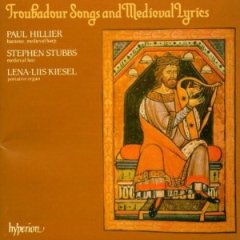Troubadour Songs and Medieval Lyrics (1991)
Troubadour Songs and Medieval Lyrics (1991)

Troubadour Songs from Provence
1. Guiraut de Borneil: Reis glorios, verais lums e clartatz
2. Bernart de Ventadorn: Can l'erba fresch'e.lh folha par play
3. Bernart de Ventadorn: Be m'an perdut lai enves ventadorn
4. Bernart de Ventadorn: Can l'erba fresch'e.lh folha par (instrumental)
5. Bernart de Ventadorn: Can vei la lauzeta mover
Medieval Lyrics
6. Anon-England: Worldës Blis play
7. Peter Abelard: Planctus David
8. Anon-Norway: Ex te lux oritur o dulcis Scocia
Paul Hillier (baritone, harp)
Stephen Stubbs (lute)
Lena-Liis Kiesel (portative organ)
A troubadour was a composer and performer of Occitan lyric poetry during the High Middle Ages (1100–1350). Since the word "troubadour" is etymologically masculine, a female troubadour is usually called a trobairitz. The troubadour school or tradition began in the 11th century in Occitania, but it subsequently spread into Italy, Spain, and even Greece. Under the influence of the troubadours, related movements sprang up throughout Europe: the Minnesang in Germany, trovadorismo in Galicia and Portugal, and that of the trouvères in northern France. Dante Alighieri in his De vulgari eloquentia defined the troubadour lyric as fictio rethorica musicaque poita: rhetorical, musical, and poetical fiction. After the "classical" period around the turn of the 13th century and a mid-century resurgence, the art of the troubadours declined in the 14th century and eventually died out around the time of the Black Death (1348). The texts of troubadour songs deal mainly with themes of chivalry and courtly love. Most were metaphysical, intellectual, and formulaic. Many were humorous or vulgar satires. Works can be grouped into three styles: the trobar leu (light), trobar ric (rich), and trobar clus (closed). Likewise there were many genres, the most popular being the canso, but sirventes and tensos were especially popular in the post-classical period, in Italy, and among the female troubadours, the trobairitz.
Trubadurzy – poeci i zarazem muzycy francuscy działający w XII i XIII wieku. Przyjęło się uważać za trubadurów tych poetów, którzy działali na południu Francji, pisząc w języku oksytańskim, langue d'oc, natomiast za truwerów – poetów z północy Francji piszących po francusku, langue d'oil. Terminem trobairitz określa się kobietę-trubadura. Działalność trubadurów była najwcześniejszym i najistotniejszym przejawem regionalnej sztuki muzycznej i poetyckiej w średniowiecznej kulturze Zachodu, a jej wpływ można dostrzec – nie tylko w epoce średniowiecza – również na terenie innych krajów europejskich. Z imienia wymienić można około 460 trubadurów, z twórczości których zachowało się około 2600 utworów – z czego jedynie około 10 posiada oryginalną melodię. Twórczość literacka trubadurów to tzw. poezja prowansalska. Z tradycji trubadurów wywodzą się truwerzy i niemieccy minnesingerzy. Poezję trubadurów i truwerów rozpowszechniali oni sami lub też wędrowni śpiewacy zwani minstrelami.
download: uploaded yandex 4shared mediafire solidfiles mega filecloudio nornar
Last Updated (Wednesday, 19 February 2014 17:34)








